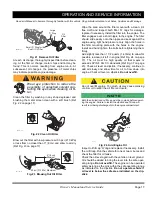
OPERATION AND SERVICE INFORMATION
Page 6
Owner’s Manual and Service Guide
Read all of Manual to become thoroughly familiar with this vehicle. Pay particular attention to all Notes, Cautions and Warnings
Do not refuel near open flame or electrical
items which could produce a spark.
Always handle gasoline in a well ventilated
area.
Always wear eye protection to protect
against splashed fuel and fuel vapors.
Always allow adequate space for the expan-
sion of gasoline. Leave at least 1" (2.5 cm)
space below bottom of filler neck.
Inspect fuel cap, tank and other compo-
nents for leaks or deterioration that could
cause a hazardous condition.
The fuel tank is located under the seat on the passenger
side of the vehicle (Ref Fig. 8 on page 6). Fill the tank
with fresh, clean, automotive grade gasoline (Ref Fig. 37
on page 23). High altitude or heavy use/load applications
may benefit from higher octane gasoline.
Do not use gasoline which contains Methanol.
Some fuels, called oxygenated or reformulated gasoline, are
gasoline blended with alcohols or ethers. Excessive amounts
of these blends can damage the fuel system or cause perfor-
mance problems. If any undesirable operating symptoms
occur, use gasoline with a lower percentage of alcohol or ether.
Fig. 8 Fueling
BATTERY
Excessive use of accessories may drain the battery and
leave insufficient reserve to start the vehicle.
The vehicle uses a combination starter/generator to both
start the engine and charge the battery. The engine will
not idle; therefore, the battery cannot be charged while
the vehicle is stopped. Do not operate accessory items
(such as lights) excessively while the vehicle is stopped.
The generator is capable of supplying 35 amps; there-
fore, operation of all accessories could result in the dis-
charge of the battery even though the engine is running
and the generator operating. Discharging the battery is
known as deep cycling. The battery is not a deep cycle
model, but is a starting battery. Multiple deep cycling will
result in the premature failure of the battery.
If the vehicle battery has become discharged, it must be
charged using a 12 volt charger that is rated at 10 amps
or less and in accordance with all instructions provided
by the manufacturer of the charger.
LABELS AND PICTOGRAMS
Vehicles may be labeled with pictograms as a method of
conveying information or warnings. Appendix A illus-
trates and explains pictograms that may appear on the
vehicle. Not all pictograms shown in Appendix A will be
found on your vehicle.
SUN TOP AND WINDSHIELD
The sun top does not provide protection from
roll over or falling objects.
The windshield does not provide protection
from tree limbs or flying objects.
The sun top and windshield provide some protection
from the elements; however, they will not keep the opera-
tor and passenger dry in a downpour. This vehicle is not
equipped with seat belts and the sun top has not been
designed to provide roll over protection. In addition, the
sun top does not protect against falling objects nor does
the windshield protect against flying objects and tree
limbs. Keep arms and legs inside of vehicle while it is
moving.
1" Min.
(2.5 cm)
Fuel
Ref Ftl 1
Summary of Contents for 605584-DK
Page 10: ...Owner s Manual and Service Guide Notes Page viii SAFETY INFORMATION ...
Page 16: ...Owner s Manual and Service Guide Notes Page xiv SAFETY INFORMATION ...
Page 45: ...Page 25 GENERAL SPECIFICATIONS Owner s Manual and Service Guide GENERAL SPECIFICATIONS ...
Page 54: ...Page 34 Owner s Manual and Service Guide GENERAL SPECIFICATIONS Notes ...
Page 55: ...Page 35 Owner s Manual and Service Guide VEHICLE WARRANTIES VEHICLE WARRANTIES ...
Page 61: ...Appendix A 1 Owner s Manual and Service Guide LABELS AND PICTOGRAMS LABELS AND PICTOGRAMS ...
Page 68: ......
Page 70: ...Appendix B 2 DECLARATION OF CONFORMITY Owner s Manual and Service Guide ...
Page 71: ...Appendix B 3 DECLARATION OF CONFORMITY Owner s Manual and Service Guide ...
Page 72: ...Appendix B 4 DECLARATION OF CONFORMITY Owner s Manual and Service Guide Notes ...
Page 74: ......
































